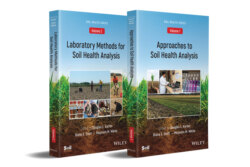Читать книгу Soil Health Analysis, Set - Группа авторов - Страница 2
Table of Contents
Оглавление1 Cover
2 Volume 1 Series Page Title Page Copyright Page Dedication Page Foreword References Preface References 1 Soil Health: An Overview and Goals for These Volumes Synopsis of Two‐Volume Book Introduction Summary and Conclusion References 2 Evolution of the Soil Health Movement Introduction Pre‐20th Century Soil Awareness From 1900 to 1970 From 1970 to 2000 – Soil Quality Emerges 21st Century Developments in Soil Health References 3 The Utility and Futility of Soil Health Assessment Chapter Overview Introduction Analytical Methods Soil Health Limitations Conclusions References 4 Metadata: An Essential Component for Interpreting Soil Health Measurements Methods and Frequency Discussion Summary Acknowledgments References 5 Soil Health Assessment of Agricultural Lands Summary Overview of Assessments Assessment Frameworks Evolving Soil Health Assessment Activities References 6 Soil Health Assessment of Forest Soils Introduction Ecosystem Examples Conclusion: Criteria and Indicators for Monitoring Forest Soil Health Summary Acknowledgments References 7 A Risk‐Based Soil Health Approach to Management of Soil Lead Introduction Urban Soil Lead Assessment and Human Exposure Soil Health Based Assessment and Management of Soil Lead Practical Assessment of Soil Lead Summary and Conclusions References 8 The Future of Soil Health Assessments: Tools and Strategies Introduction References Epilogue References
3 Volume 2 Series Page Title Page Copyright Page Dedication Page Foreword References Preface References 1 Laboratory Methods for Soil Health Assessment: An Overview How Can a Farmer Assess Soil Health in the Field? What Do Researchers Need, and Can They Reach Consensus? What Do Commercial Analytical Laboratories Need? Summary and Conclusions References 2 Sampling Considerations and Field Evaluations for Soil Health Assessment Introduction Soil Variability Sampling Considerations Sample Collection, Processing, and Archival Field Evaluations Summary Acknowledgments References 3 Soil Organic Carbon Assessment Methods Summary Introduction References 4 Water‐Stable Soil Aggregate Assessment Introduction Soil sampling and preparation Water‐stable aggregation (WSA) Materials and Procedures Aggregate Sieving Apparatus Construction Supplies Water‐stable aggregate size distribution with the slaking method Sand‐Free Water‐Stable Soil Aggregates Supplies and procedure for sand content determination Aggregate mean weight diameter Summary References 5 Determination of Infiltration Rate and Bulk Density in Soils Soil Infiltration Soil Bulk Density Acknowledgments References 6 Chemical Reactivity: pH, Salinity and Sodicity Effects on Soil Health Introduction Natural Soil Salinization Processes Salt Accumulation and Solute Transport Mechanisms Anthropogenic Soil Salinization Processes Chemical Characterization of Salinity Sources Soil Chemistry, Biota and Ecosystem Services Chemistry Effects on Soil Biota Habitat Heterogeneity and Soil Microbial Diversity Agricultural Ecosystems: Degradation Prevention and Conservation Soil Health Indices Technological Advances in the Study of Soil Biogeochemical Interfaces Conclusions References 7 Nutrient Availability: Macro‐ and Micronutrients in Soil Quality and Health Introduction Conclusions References 8 Assessment and Interpretation of Soil‐Test Biological Activity Introduction Literature Review of Indicator and Method Method Interpretations References 9 Permanganate Oxidizable Carbon Soil Organic Carbon Pools Indicators of Biologically Active soil Carbon Permanganate‐Oxidizable Carbon Procedure to Quantify Poxc References 10 Is Autoclaved Citrate‐Extractable (ACE) Protein a Viable Indicator of Soil Nitrogen Availability? Introduction Nitrogen Availability Indices Autoclaved Citrate‐Extractable Protein Soil Sampling Considerations Methods and Materials for Protein Quantification Summary and Conclusions References 11 Metabolic Activity– Enzymes Introduction Enzymes as Soil Health Indicators Soil Sampling and Handling Method Interpretation– Putting Enzyme Measurements into Context References 12 PLFA and EL‐FAME Indicators of Microbial Community Composition Introduction PLFA Using the Buyer and Sasser (2012) High‐throughput Extraction Method Paired with the MIDI‐Sherlock System EL‐FAME Extraction Paired with the MIDI‐Sherlock System Tips and Tricks for FAME Extraction and Analysis Calculations and Interpretation of FAME Data Management Implications References 13 Microbial Community Composition, Diversity, and Function Introduction Methods for Identifying and Quantifying Microbial Communities Criteria for Method Selection Selected Method Protocol Analysis Section References Epilogue References
4 End User License Agreement
